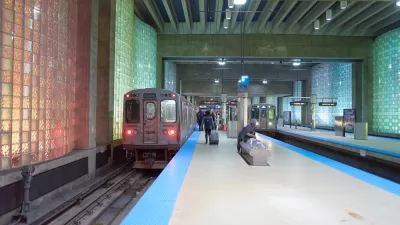After another big announcement from the realm of futuristic transportation, there's reason to remain skeptical.

Alissa Walker reports the news that Hyperloop One recently released a plan for 11 Hyperloop routes connecting 35 major cities earlier this month.
Vision for America, as the plan is called, "would connect 83 million Americans, including routes linking Los Angeles to San Diego, Dallas to Austin, Texas, and a mega-route serving cities from Cheyenne to Houston," according to Walker. "The routes are the U.S. finalists for a Hyperloop One competition, where teams submitted proposals for the most promising Hyperloop corridors around the world, based on estimated ridership and economic potential."
Hyperloop One’s senior business analyst Rehi Alaganar writes a post to explain the plan, comparing the vision for the Hyperloop to the Interstate Highway System.
Angie Schmitt also wrote on the subject of the Hyperloop this week, noting that the ides has yet to deliver a functional, real-world example of the technology. "Anyone who believes it’s a viable endeavor is basically taking it on faith," writes Schmitt. Yet, Schmitt notes, "a surprising number of government agencies are treating the Hyperloop as a serious proposition." Schmitt's article lists some of the agencies that seem to be buying into the Hyperloop hype before responding directly to some of the talking point that companies like Hyperloop One are relying on to market the idea. Schmitt's final assessment: "America has the means to reduce traffic and connect people to where they want to go in less time — but solving these problems entails politically difficult choices to shift travel away from cars and highways. Any high-tech solution that promises a shortcut around these thorny problems is probably too good to be true."
FULL STORY: Hyperloop One reveals plan to connect 35 U.S. cities

Alabama: Trump Terminates Settlements for Black Communities Harmed By Raw Sewage
Trump deemed the landmark civil rights agreement “illegal DEI and environmental justice policy.”

Study: Maui’s Plan to Convert Vacation Rentals to Long-Term Housing Could Cause Nearly $1 Billion Economic Loss
The plan would reduce visitor accommodation by 25% resulting in 1,900 jobs lost.

Why Should We Subsidize Public Transportation?
Many public transit agencies face financial stress due to rising costs, declining fare revenue, and declining subsidies. Transit advocates must provide a strong business case for increasing public transit funding.

Paris Bike Boom Leads to Steep Drop in Air Pollution
The French city’s air quality has improved dramatically in the past 20 years, coinciding with a growth in cycling.

Why Housing Costs More to Build in California Than in Texas
Hard costs like labor and materials combined with ‘soft’ costs such as permitting make building in the San Francisco Bay Area almost three times as costly as in Texas cities.

San Diego County Sees a Rise in Urban Coyotes
San Diego County experiences a rise in urban coyotes, as sightings become prevalent throughout its urban neighbourhoods and surrounding areas.
Urban Design for Planners 1: Software Tools
This six-course series explores essential urban design concepts using open source software and equips planners with the tools they need to participate fully in the urban design process.
Planning for Universal Design
Learn the tools for implementing Universal Design in planning regulations.
Smith Gee Studio
Alamo Area Metropolitan Planning Organization
City of Santa Clarita
Institute for Housing and Urban Development Studies (IHS)
City of Grandview
Harvard GSD Executive Education
Toledo-Lucas County Plan Commissions
Salt Lake City
NYU Wagner Graduate School of Public Service




























